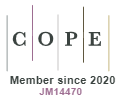Correlational analysis during and after the cycle of chemotherapy with the anxiety profile of people with cancer
DOI:
https://doi.org/10.5585/conssaude.v16n1.6965Keywords:
Anxiety, Neoplasms, Drug Therapy.Abstract
Introduction: The emotional distress experienced by cancer patients added to the negative thoughts favours the occurrence of anxiety and depression. Objective: Correlating the reported anxiety with the sociodemographic and clinical variables of cancer patients during and after chemotherapy. Methods: In this study, 38 volunteers (age: 58.24 ± 14.19) were submitted to chemotherapeutic treatment (TG) and nine volunteers who had already completed the treatment (CG) (age: 59.78 ± 18.23) were evaluated. For all volunteers the State - Trait Anxiety Inventory (STAI) was used to measure the anxiety profile. Results: For the body mass and BMI of the TG, a Spearman’s correlation coefficient r = -0.590 (p <0.001) and r =-0.477 (p = 0.002), respectively. For the GC the same variables had a Spearman’s correlation coefficient r=0,786 (p=0,036) and r= 0.683 (p=0.042), respectively. Conclusion: Both groups showed significant correlations of anxiety level for the clinical variables, but the CG showed a higher correlation of anxiety level with these variables in comparison with to TG.Downloads
Downloads
Published
2017-06-14
How to Cite
1.
Vallim L de B, Souza JB de, Alves R da S, Iunes DH, Chaves Érika de CL, Carvalho CC, et al. Correlational analysis during and after the cycle of chemotherapy with the anxiety profile of people with cancer. Cons. Saúde [Internet]. 2017 Jun. 14 [cited 2025 May 22];16(1):124-30. Available from: https://periodicos.uninove.br/saude/article/view/6965
Issue
Section
Artigos
License
Copyright (c) 2017 ConScientiae Saúde

This work is licensed under a Creative Commons Attribution-NonCommercial-ShareAlike 4.0 International License.
Views
- Abstract 348
- PDF (Português (Brasil)) 226






